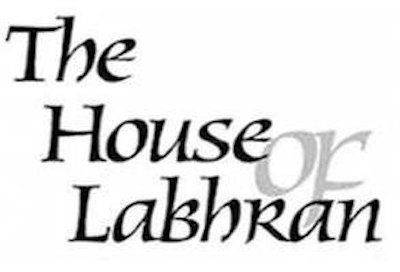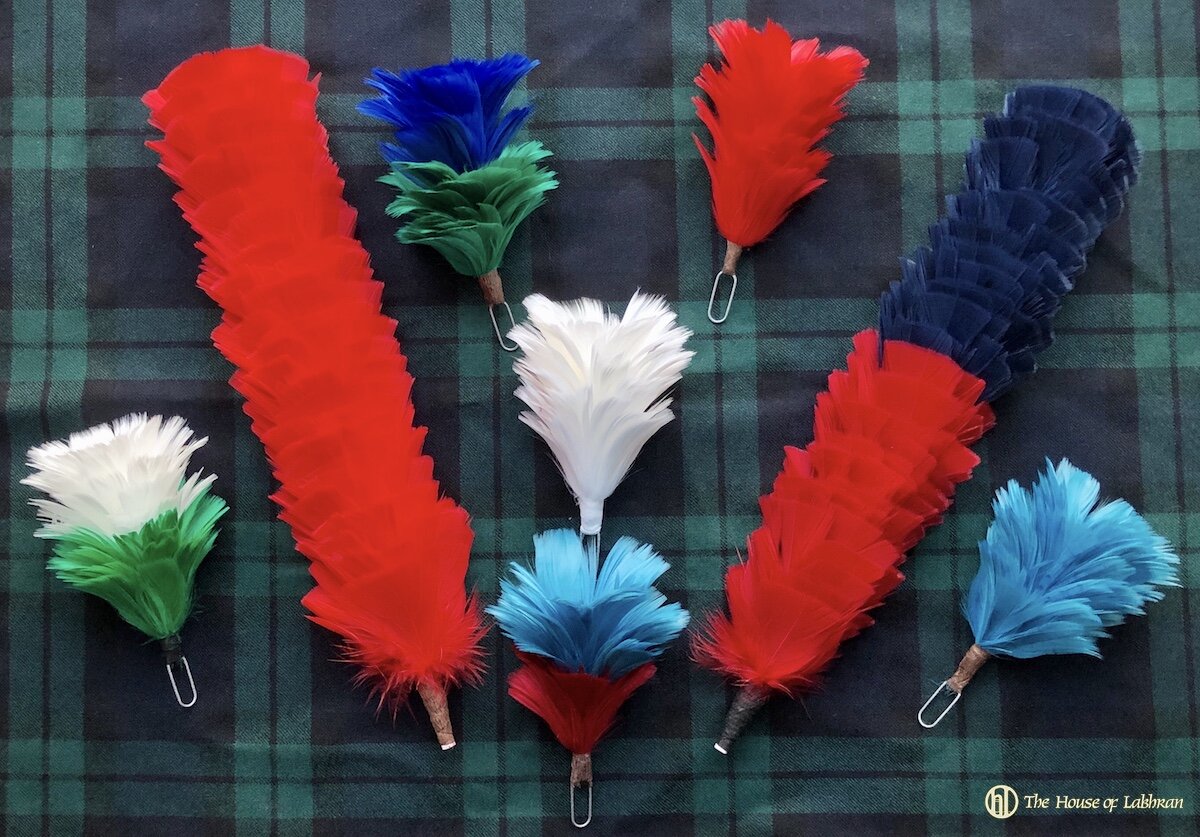Feather Hackles & Plumes - Regimental Traditions
Feather Hackles - Regimental Traditions
Feather Hackles - Regimental Traditions. The hackle is a clipped feather plume that is attached to a military headdress. In the British Army and the armies of some Commonwealth countries, the hackle is worn by some infantry regiments, especially those designated as fusilier regiments and those with Scottish and Northern Irish origins. The colour of the hackle varies from regiment to regiment. The modern hackle has its origins in a much longer plume, originally referred to by its Scots name, heckle, which was commonly attached to the feather bonnet worn by Highland regiments (now usually only worn by drummers, pipers and bandsmen). The smaller version originated in a regimental emblem adopted by the 42nd Black Watch Royal Highland Regiment, to be worn in the sun helmet issued in hot-weather postings from the 1870s.The black cock style feather hackle has long been used by both regiments and civilian wear in the glengarry and Kilmarnock bonnet since the mid nineteenth century. These are styled on the tail feathers of the Black grouse. In the past these have also been presented as prizes for Highland dancing, piping and civilian shooting competitions.We supply a wide range of high quality Scottish regimental and civilian feather hackles and plumes. All 100% made in the UK to the high quality expected by the Scottish regiments and British army.Perfect addition to any glengarry, Balmoral, Lowland bonnet, Irish caubeen or feather bonnets.As supplied to regiments and pipe bands around the world.
To order hackles please visit the Scottish & Irish hackle department.
Royal Regiment of Scotland
Following the amalgamation of the regiments of the Scottish Division to form The Royal Regiment of Scotland on 28 March 2006, the following hackles are being worn by the regiment's constituent battalions:
Feather Bonnet Hackle - Regimental Traditions
Royal Scots Borderers (1 SCOTS): Black
Royal Highland Fusiliers (2 SCOTS): White
Black Watch (3 SCOTS): Red
The Highlanders (4 SCOTS): Blue
Argyll and Sutherland Highlanders (5 SCOTS): Green
52nd Lowland Volunteers (6 SCOTS): Grey
51st Highland Volunteers (7 SCOTS): Purple
Blackcock style hackle worn by regimental pipers
Hackles are available from the Hackle department of the online shop
Whilst the white hackle of 2 SCOTS, red hackle of 3 SCOTS and blue hackle of 4 SCOTS have a known ancestry, the origin of 1 SCOTS black hackle and 5 SCOTS green hackle are not clear and have no apparent precedent. It may be that the black hackle of 1 SCOTS simulates the black-cock tail feathers originally worn in the 1904 pattern Kilmarnock Bonnet and latterly in the regimental Glengarry Cap by the Royal Scots and King's Own Scottish Borderers, who merged in August 2006 to form 1 SCOTS.Alternatively, it may be a sympathetic gesture to a former Lowland regiment, the Cameronians (Scottish Rifles), who went into 'suspended animation' in 1968 (and later disbanded), who wore a black hackle in their rifle green dress Balmoral. The adoption of the green hackle now being worn by the Argylls battalion (5 SCOTS) is no doubt a continuation of that regiment's association with the colour green, most prominent in the hue of their regimental kilts and stripes on their regimental association ties. (It is, however, worthy of note that in the 19th Century, all line regiments of the British Army used to designate their "light company" with a green hackle.)The Regimental Band of the Royal Regiment of Scotland does not wear the hackle. However, the Highland Band of the Royal Regiment of Scotland (Territorial Army) continues to wear the red hackle with the Tam o' Shanter. Tradition holds that the black hackle originated as a Scottish tradition of wearing a black feather in your hat to signify you have an ongoing quarrel with someone.
Historic fusilier regiments
There were several other fusilier regiments which have been amalgamated and no longer exist. The hackle colours worn were as follows:
Lancashire Fusiliers: Primrose yellow
Royal Fusiliers (City of London Regiment): White
Royal Inniskilling Fusiliers: Grey
Royal Irish Fusiliers: Green
Royal Northumberland Fusiliers: Red over White
Royal Scots Fusiliers: White
Royal Warwickshire Fusiliers: Blue over Old Gold (Orange)
Royal Welsh Fusiliers: White
Royal Munster Fusiliers: White over Green
Royal Dublin Fusiliers: Green over Blue
Modern fusiliers regimental hackles
In the modern British Army, there is a single regiment of fusiliers, plus a battalion of a large regiment. Hackle colours are:
Royal Regiment of Fusiliers: Red over white
Royal Highland Fusiliers (a battalion of the Royal Regiment of Scotland): White
Other ranks of the Royal Welsh; the regiment that was formed by the amalgamation of the Royal Welsh Fusiliers and Royal Regiment of Wales, continue to wear the white hackle of the Royal Welsh Fusiliers.
To see the full range of bonnet hackles visit the online shop
Non-fusilier regiments
Non-fusilier regiments which wear the hackle are:
Irish Guards (pipers on caubeen only): St Patrick's blue
Liverpool Scottish (now a platoon of A (Ladysmith) Company, 4th Bn Duke of Lancaster's Regiment): Royal blue
Liverpool Irish (now A Troop of 208 Battery, 103rd Regiment Royal Artillery): Blue over red
London Irish Rifles (now D (London Irish Rifles) Company, London Regiment): Green [Pipers wear St Patrick's blue]
Royal Irish Regiment (as the direct descendant of two regiments of fusiliers): Green
Royal Scots Dragoon Guards (on pipers' feather bonnet in Full Dress, pipers' / drummers' glengarry /atholl bonnet in No.1 and No.2 dress): White
Royal Welsh (Other Ranks only): White
Scots Guards (pipers on feather bonnet only): Blue over red
The Queen's University Officers' Training Corps: St Patrick's Blue (A Coy Caubeen Only)
Royal Air Force (pipe band only): Blue
REME Blue over yellow over red ( Pipers glengarry hackle )
Royal Tank Regiment Blackcock feather hackle ( Pipers glengarry hackle )
Other regiments
Former non-fusilier regiments, now amalgamated, which also wore the hackle were:
40 (Ulster) Regiment, Royal Corps of Signals: Navy blue, sky blue and green.
Argyll and Sutherland Highlanders: (feather bonnet only - Drummers and Drum Major): White
Argyll and Sutherland Highlanders: (Pipers only) Black Cock Feather
Black Watch: Red
The Cameronians (Scottish Rifles): Black
Gordon Highlanders: Feather bonnet only - Drummers and Drum Major: White, Bandsmen: Red and White
Gordon Highlanders: (Pipers only) Black Cock Feather
Highland Light Infantry: White over red
The Highlanders (Seaforth, Gordons and Camerons): Royal blue
The Highlanders (Seaforth, Gordons and Camerons): (feather bonnet only - Drummers and Drum Major) White
The Highlanders (Seaforth, Gordons and Camerons): (Pipers only) Eagle feather
Queen's Own Cameron Highlanders: Royal blue
Queen's Own Cameron Highlanders: (feather bonnet only - Drummers and Drum Major) White
Queen's Own Cameron Highlanders: (Pipers only) Eagle feather
Queen's Own Highlanders (Seaforth and Camerons): Royal blue
Queen's Own Highlanders (Seaforth and Camerons): (feather bonnet only - Drummers and Drum Major) White
Queen's Own Highlanders (Seaforth and Camerons): (Pipers only) Eagle feather
Queen's Royal Irish Hussars (pipers on caubeen only): White over red
Royal Irish Rangers: Green
Royal Corps of Transport (pipers on feather bonnet only): Red over white over blue
Royal Ulster Rifles: Black
Seaforth Highlanders (feather bonnet only - Drummers and Drum Major): White
Seaforth Highlanders (Pipers only) Black Cock Feather
No. 9 Commando and No. 11 (Scottish) Commando: Black
Canadian Army
There are several fusilier regiments in the Canadian Army which wear the hackle (the French-speaking fusilier regiments do not appear to do so):
The Princess Louise Fusiliers: French grey
The Royal Highland Fusiliers of Canada: White
Royal 22e Régiment: Red (not otherwise considered a fusilier regiment, they wear fusilier full dress because of their alliance with the Royal Welch Fusiliers)
Scottish-influenced non-fusilier regiments which wear the hackle include:
48th Highlanders of Canada (feather bonnet only): White
The Argyll and Sutherland Highlanders of Canada (Princess Louise's) (drummers on feather bonnet only): White
The Black Watch (Royal Highland Regiment) of Canada: Red
The Calgary Highlanders (drummers on feather bonnet only): White
The Cameron Highlanders of Ottawa (Duke of Edinburgh's Own): Royal blue
The Canadian Scottish Regiment (Princess Mary's) (drummers on feather bonnet only): White
The Essex and Kent Scottish (feather bonnet only): White
The Lorne Scots (Peel, Dufferin and Halton Regiment): Primrose yellow
The Queen's Own Cameron Highlanders of Canada: Royal blue (except pipers in full dress, who wear an eagle feather instead).
The Seaforth Highlanders of Canada (drummers on feather bonnet only): White
Irish-influenced non-fusilier regiments which wear the hackle (on the caubeen):
2nd Battalion, Irish Regiment of Canada: Green (light blue for senior NCOs and officers)
South African Army
Scottish- and Irish-influenced regiments which wear the hackle include:
South African Irish Regiment: Green
Transvaal Scottish Regiment: Red
Witwatersrand Rifles: Black
Feather Hackles - Regimental Traditions












